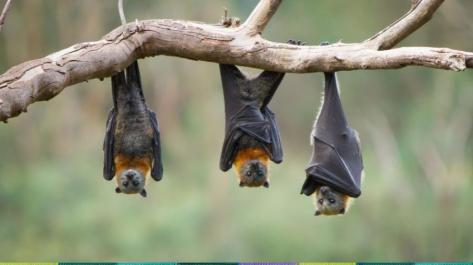Bats: Friend or Foe?

It is a bit awkward to be giving a tour of meeting space at the church to an organization who would like to hold an event here at NUMC and have the person say “did you know there is a bat hanging in your hallway above the entrance to the church?” Yep, that happened. Enter our resident “batman” Arturo to humanely remove the bat and relocate it outside where it belongs. Arturo has gotten very good at bat removal. He even has a “bat removal” kit which includes gloves, a garbage can and plastic bags. Arturo has bat removal down to a science since he has had to perform this duty on several occasions as bats seem to find their way into the NUMC building often and require relocation to a more suitable place, such as outside.
I like to write about the various animals and critters that call the NUMC campus home, however, I wouldn’t say that bats are one of my favorite creatures that frequent the NUMC campus. While not the cutest (depending on your perspective) or most cuddly (not recommended) of God’s creatures, they are actually very important to the balance of our environment and ecosystem. Bats can easily enter a building through a small opening in an attic, wall space, chimney or through open doors and windows. When you spot a bat, typically the first instinct is to reach for a broom or some blunt object to harm the bat, but bats should always be removed to a suitable location humanely. Bats play an essential role in pest control, pollinating plants and dispersing seeds. While many bats eat insects, others feed on nectar and provide critical pollination for a variety of plants like avocadoes, mangoes, peaches, cloves, bananas and agaves. In fact, bats are the sole pollinator for the agave plant, a key ingredient in tequila! Bat colonies consume thousands of mosquitoes and other pests every night, lessening the need for pesticides and bug spray. Although Minnesota’s bats do not aid directly in plant pollination, they do feed on a host of agricultural pests that damage crops and forests, providing an estimated $3 billion in ecosystem benefits annually in the U.S. alone.
Unfortunately, bats are declining across the globe. Many are needlessly killed because people do not understand the important role they play in a healthy ecosystem. The loss of habitat and disruptions during hibernation are also detrimental to the bat population. They only have one baby (pup) per year so repopulating is a slow process. Making matters worse, a fungal disease called whitenose syndrome has claimed the lives of millions of bats and has spread across North America at an alarming rate.
Bats are actually our friends, even though we tend not to realize it. Bats are nothing to be afraid of, and we definitely shouldn’t be trying to get rid of them. They are amazing creatures. Bats can live more than 30 years and fly at speeds of 60 miles per hour or more. They can eat up to 1200 mosquitoes an hour and often consume their body weight in insects every night. Bats can find their food in total darkness by emitting inaudible high-pitched sounds, 10-20 beeps per second, and listening to echoes. This is called echolocation. By using echolocation, they bounce sounds off the objects around them, creating a three-dimensional picture in their brain. Studying the echolocation in bats has led to advancements in the ways visually impaired people can navigate!
What can you do to help bats?
• Turn off unnecessary lights and watch for bats. Light pollution can disrupt or deter bats.
• Promote natural habitat around your home. Leave dead and dying trees in areas where they don’t create a hazard - they may be used as roosting sites for bats! Create a garden to help attract insects that pollinate plants and feed bats.
• Feed hungry bats by minimizing the use of pesticides in your yard. A single bat can eat up to 3,000 insects in a single night!
• Provide shelter by installing a bat box. Providing shelter for bats is a great way to promote a healthy environment.
• Avoid disturbing bats. Stay out of caves and mines where bats are hibernating in winter.
• Remove unwanted bats humanely. If a bat accidentally flies into your home, remove it safely without harming the bat.
Simply left alone, bats are harmless and highly beneficial. They are fascinating creatures, vital to the balance of nature around the world. Like most wild animals, bats prefer to avoid contact with humans. But in situations where bats and humans come into close proximity, it is important to understand how to prevent negative outcomes for both. Unfortunately, bats are the leading cause of rabies deaths in people in the United States. People and domestic animals should avoid contact with bats. Rabies can spread to people from bats after even a minor bite or scratch. If you know you’ve been bitten or scratched by a bat wash the wound thoroughly with soap and water and seek immediate medical attention. If possible, the bat should be captured and sent to a laboratory for rabies testing.
Who knew the bat played such an important role in the lives of humans? God’s world does not depend on us fully understanding it for it to be remarkable and amazing. The bat is truly a remarkable creature that was put here for a specific purpose. While it may scare us at times, once we take a closer look we find that bats truly are our friends. After a little research, I have a new respect for bats. I may still cringe and call Arturo for bat removal when I come across one in the hallways of NUMC, but I’ll do it with a new found respect for one of God’s most misunderstood creatures. - Sandy Vesledahl, NUMC Office Administrator
